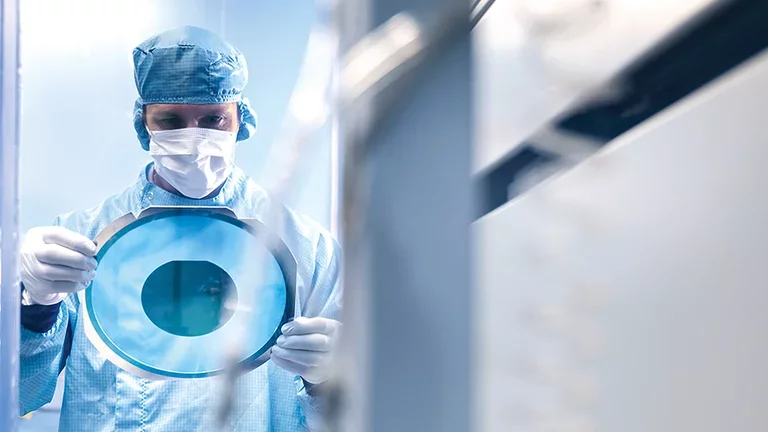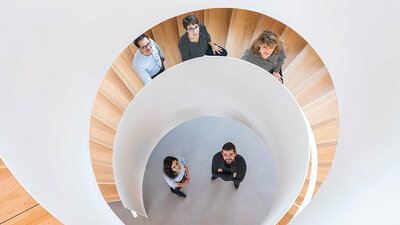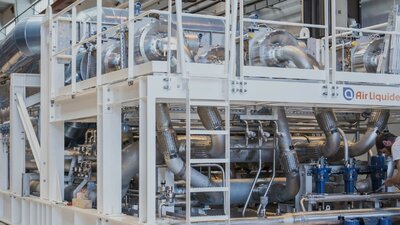In the race for innovation: electronics and deep tech
Published on July 29, 2021
5 minutes

Innovation never stops. It’s the lifeblood of our customers’ industries, and it’s in our DNA. In 2020, as the world adapted to the Covid-19 crisis, Air Liquide picked up the pace to meet accelerated demand for digital technology, energy transition and scientific research. From the electronics industry to space exploration and quantum computing, the Group continued bringing its scientific expertise and entrepreneurial spirit to help its customers move forward faster and match the evolution of society.
Responding to the changing world
While the pandemic locked people indoors, it also unleashed digital technology adoption, as work, study and play all shifted online. According to an annual McKinsey & Co survey1, consumers and companies made a quantum leap to online channels, accelerating digital interactions by three to four years. Surveyed companies reported being seven years ahead in their switch to digital-enabled products – changes that are expected to stick.
In electronics, this created a surge in demand for hardware, especially computers, tablets and smart TVs, along with higher-capacity, more robust digital infrastructure. Rather than subside, demand remained robust throughout the year as the world adapted to the “new normal”. And despite the disruption to human lives and business processes, electronics manufacturers kept pursuing innovation. During this unprecedented time, Air Liquide continued working alongside global electronics leaders to design and supply the high-purity gases, advanced materials and specialized services needed to manufacture increasingly high-performance technology at an industrial scale. The ongoing challenge is to produce faster, more powerful and feature-rich devices while reducing the financial and environmental costs. This involves ever more complex processes and smaller components, particularly nanometric-scale microchips (as little as 5 nanometers), which require the utmost precision and quality.
To meet these new challenges, Air Liquide can rely on its network of Innovation Campuses and Product Development Labs. With these collaborative resources, the Group invents the kind of customized advanced materials that lead to breakthroughs in industry standards. This is the case, for example, for its enScribe™ range of etching gases, which facilitate the manufacturing of complex 3D memory structures while greatly reducing the environ - mental impact. The use of advanced materials enabled Air Liquide’s key customers to reduce their CO2 emissions by 140,000 tons in 2020, and these savings should reach 240,000 tons by 2025.
Laurent Langellier
Markets, Customers and Products Vice President at Air Liquide’s Electronics business line
From the infinitely small to the great unknown
In 2020, Air Liquide also pursued its partnership with the space industry, where the Group’s unique technological expertise, especially in extreme cryogenics, has made it a major contributor to exploration programs. The Group is participating in Europe's Ariane launcher program and NASA's space programs, contributing to several space exploration missions (MeteoSat Third Generation, IASI-NG2, ExoMars, LunaEnergy) and collaborating with the International Space Station (on the MELFI3 refrigeration system).
For more than 50 years, the Group has been developing innovative cryogenic technologies for space exploration. For example, the Group is participating in the ExoMars mission, which consists of sending a rover to Mars in 2022 to analyze the composition of its subsurface. This rover is equipped with high precision analytical instruments, in particular a chromatograph supplied with helium through a regulation system and a tank designed by Air Liquide
From space-age technology to the energy transition
The extreme cryogenics technologies developed by Air Liquide for the space industry also serve a diverse range of industries on planet Earth, from industrial manufacturing and transportation to scientific research. One particularly successful application is Turbo-Brayton, originally developed to keep biological samples cold on the International Space Station. In orbit since 2006 without any maintenance, this solution is increasingly popular among shipping companies transporting liquefied natural gas (LNG) between producing and consuming countries. Onboard large LNG tankers, it prevents “boil-off” during transport when the gas, cold in its liquid state (-160°C), warms up and partially evaporates (up to 6 metric tons per hour). To limit the financial losses and the negative environmental impact of these “fugitive” CO2 emissions, shippers are increasingly requiring shipowners to fit their ships with preventative systems.
The efficiency and reliability of the Turbo-Brayton solution also opens the door to renewable energy applications. For example, it can be used to liquefy biogas from recovery plants, which produce methane from household, agricultural and industrial waste. In its liquid form, the gas can then be easily transported to its point of use, such as refueling stations for natural gas vehicles. These initiatives have already been introduced in the Nordic countries in Europe.
Benjamin Michel
Space business unit Director at Air Liquide's Global Markets & Technologies activity
Ultra-low temperatures for new heights in research
The Group will be supporting large-scale research experiments, thanks to a new agreement with the Hefei Institutes of Physical Science and the Chinese Academy of Science (HFIPS) to jointly develop and manufacture helium refrigeration systems in China.
Thanks to its technological expertise, Air Liquide is constantly innovating and adapting its solutions to meet the needs of its customers, while opening the path to new markets. This expertise perfectly positions the Group in the race for future growth.
Air Liquide's Electronics activity is a world reference in designing, manufacturing and supplying of molecules and equipment for semiconductor, photovoltaic cell, flat panel manufacturers…
The Global Markets & Technologies (GM&T) activity offers technological solutions (molecules, equipment and services) to support the new energy transition and deep tech (disruptive technologies based on scientific breakthroughs of such a nature as to change the methods of design and production) markets, such as extreme cryogenics for scientific research or space exploration.
2. The Atmospheric Infrared Sounding Interferometer-New Generation is an instrument designed by the Centre National d'Études Spatiales and installed on board meteorological satellites. Its objective is to provide observations of the atmosphere for weather forecasting.
3. MELFI is a cryo-refrigerator for use on board the International Space Station (ISS) for freezing and storing biological samples and other research specimens at temperatures as low as -95°C, before they are brought back to Earth.



